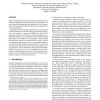Free Online Productivity Tools
i2Speak
i2Symbol
i2OCR
iTex2Img
iWeb2Print
iWeb2Shot
i2Type
iPdf2Split
iPdf2Merge
i2Bopomofo
i2Arabic
i2Style
i2Image
i2PDF
iLatex2Rtf
Sci2ools
ASPLOS
1996
ACM
1996
ACM
The Structure and Performance of Interpreters
Interpreted languages have become increasingly popular due to demands for rapid program development, ease of use, portability, and safety. Beyond the general impression that they are "slow,"however, little has been documented about the performance of interpreters as a class of applications. This paper examines interpreter performance by measuring and analyzing interpreters from both software and hardware perspectives. As examples, we measure the MIPSI, Java, Perl, and Tcl interpreters running an array of micro and macro benchmarks on a DEC Alpha platform. Our measurementsof these interpreters relate performance to the complexity of the interpreter's virtual machine and demonstrate that native runtime libraries can play a key role in providing good performance. From an architectural perspective, we show that interpreter performance is primarily a function of the interpreter itself and is relatively independent of the application being interpreted. We also demonstrate tha...
ASPLOS 1996 | Interpreter | Interpreter Performance | Interpreters Relate Performance | Programming Languages |
| Added | 08 Aug 2010 |
| Updated | 08 Aug 2010 |
| Type | Conference |
| Year | 1996 |
| Where | ASPLOS |
| Authors | Theodore H. Romer, Dennis Lee, Geoffrey M. Voelker, Alec Wolman, Wayne A. Wong, Jean-Loup Baer, Brian N. Bershad, Henry M. Levy |
Comments (0)

